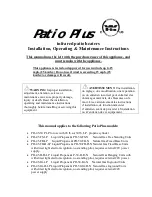
12
13
EN
Q2
Note: If the heating function is not started after turning on the device, the device will turn off automati-
cally. The air curtain remains in standby mode for 30 seconds after switching on.
4. OVERHEATING PROTECTION
This air curtain is protected by an overheating protection that automatically switches off the device in
case of overheating, for example: due to complete or partial obstruction of the air vents. In this case,
disconnect the device, wait about 30 seconds for it to cool down, and remove the object blocking the
ventilation holes. Then turn on the heater again. The device should now function normally. If the pro-
blem persists, please contact service for help.
5. CLEANING AND MAINTENANCE
•
Before starting the cleaning and maintenance process, disconnect the device from the power
supply.
•
It is recommended to use a soft damp cloth and neutral detergent for cleaning. Do not use abrasive
cloths or appliances or cleaning agents that could damage the casing of the appliance.
•
Check that the hot air outlet and air inlet are free of dust and dirt.
•
When cleaning, be careful not to touch the heating elements.
•
To open the rear filter for cleaning, press the top of the plastic grille on the back of the device.
•
In the event of failure and / or malfunction of the device, disconnect it from the power supply and
contact an authorized service center.
WARNING! As a result of continuous development works, the appearance and specification of the pro-
duct may slightly differ from the device shown on the packaging.
6. TECHNICAL SPECIFICATIONS
Model
Voltage
Power
Q2
AC220-240V 50/60Hz
2000W
7. DISPOSAL OF THE PRODUCT
According to the European Directive 2002/96 / EC, the product should not be disposed of
as unsorted municipal waste at the end of its service life. The device must be delivered to
the appropriate collection points. Some of the chemicals in the electrical / electronic
components of the device or batteries can be harmful to the environment and human
health, and proper disposal helps to avoid these negative consequences. Consult local
waste management for information on available recycling and / or disposal options. This
obligation is marked with the symbol of a crossed out trash can.


































